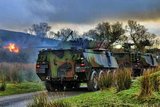Raytheon takes networking to the tactical edge for US Air Force's JADC2 enterprise
Raytheon is one of nine companies selected to demonstrate individual network elements for the Advanced Battle Management System. (Image: Raytheon)
Raytheon Intelligence & Space has been selected to develop a Common Tactical Edge Network (CTEN) to support the USAF's Advanced Battle Management System (ABMS), as one of nine companies contracted to demonstrate elements of the network.
CTEN enables edge networking for distributable battle management C2 in contested environments to support the DoD-wide Joint All-Domain Command and Control (JADC2) enterprise.
Raytheon will build on existing networking products to demonstrate an architecture for aerial network interoperability. The company will apply model-based systems engineering and DevSecOps methodology as the basis for the design.
Related Articles
US Air Force battle lab to support JADC2 efforts
Rules may need to be broken for successful rollout of JADC2
JADC2 may be a solution with no problem, US commanders say
'We have a rich history of creating resilient, collaborative and secure networks,' said Paul Meyer, president, Department 22 at RI&S. 'This enables us to put forward a solution ready to meet the US Air Force’s need for an interoperable and integrated convergence layer.'
Raytheon was also recently selected as an industry partner for the air force's ABMS Digital Infrastructure Consortium.
RI&S's work will be carried out through the Air Force Life Cycle Management Center's Aerial Networks Division at Hanscom AFB, Massachusetts. Selected companies will demonstrate their solutions in Q4 this year.
More from Digital Battlespace
-
![Babcock nears first customer for Nomad AI translation tool]()
Babcock nears first customer for Nomad AI translation tool
Nomad can provide militaries with real-time intelligence, saving critical time on the battlefield.
-
![AUSA 2025: Israel’s Asio Technologies to supply hundreds of improved Taurus tactical systems]()
AUSA 2025: Israel’s Asio Technologies to supply hundreds of improved Taurus tactical systems
Taurus operates alongside the Israel Defense Forces’ Orion system which supports mission management across tens of thousands of manoeuvring forces, from squad leaders to battalion commanders.
-
![AUSA 2025: Kopin pushes micro-LED plans as China moves faster]()
AUSA 2025: Kopin pushes micro-LED plans as China moves faster
The plan for the new displays follows fresh investment in Kopin’s European facilities by Theon and an order for head-up displays in fielded aircraft, with funding from the US Department of Defense.
-
![AUSA 2025: Persistent Systems to complete its largest order by year’s end]()
AUSA 2025: Persistent Systems to complete its largest order by year’s end
Persistent Systems received its largest ever single order for its MPU5 devices and other systems earlier this month and has already delivered the 50 units to the US Army’s 4th Infantry Division.
-
![Aselsan brings in dozens of companies and systems under the Steel Dome umbrella]()
Aselsan brings in dozens of companies and systems under the Steel Dome umbrella
Turkey has joined the family of countries attempting to establish a multilayered air defence system with government approval in August 2024 for the effort landed by Aselsan. Dubbed Steel Dome, the programme joins Israel’s Iron Dome, the US Golden Dome, India’s Mission Sudarshan Chakra and South Korea’s low-altitude missile defence system.
-
![DSEI 2025: MARSS unveils new agnostic multidomain C4 system]()
DSEI 2025: MARSS unveils new agnostic multidomain C4 system
MARSS’ NiDAR system has been deployed using sensors from static platforms to provide detection and protection for static sights, such as critical infrastructure, ports and military bases.




























